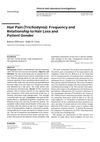TLDR Chronic scalp pain in trichodynia involves both body-wide and localized increased pain sensitivity.
The document presents a study that investigated the mechanisms behind chronic scalp pain in trichodynia patients, involving 16 patients and 19 healthy controls. The study found that trichodynia patients had lower thresholds for light touch and pressure pain, a high rate of static allodynia, and a significant negative correlation between pain intensity and scalp thresholds. Pain was associated with hair cycle abnormalities and was accompanied by generalized hyperalgesia, as evidenced by lower pressure-pain thresholds in the hands. The presence of increased inflammatory markers and neurogenic inflammation suggests peripheral sensitization, while symptoms in non-scalp areas suggest central sensitization. The study concludes that both peripheral and central sensitization are involved in trichodynia, with potential implications for treatment strategies targeting these sensitizations. However, the study had limitations, including a small sample size and lack of examiner blinding.
489 citations
,
June 2005 in “The FASEB Journal” Human hair follicles can produce cortisol like the body's stress response system.
 46 citations
,
September 2003 in “International Journal of Dermatology”
46 citations
,
September 2003 in “International Journal of Dermatology” Trichodynia found in 29% of TE or AGA patients, linked to psychological conditions.
 194 citations
,
March 2003 in “American Journal of Pathology”
194 citations
,
March 2003 in “American Journal of Pathology” Stress stops hair growth in mice by causing early hair growth phase end and harmful inflammation through a specific nerve-related pathway.
 41 citations
,
July 2002 in “Clinical and Experimental Dermatology”
41 citations
,
July 2002 in “Clinical and Experimental Dermatology” Effective hair loss assessment requires a mix of precise measurement methods.
 48 citations
,
January 2002 in “Dermatology”
48 citations
,
January 2002 in “Dermatology” Hair pain is more common in women with hair loss, but it's not linked to the cause or severity of hair loss.
 236 citations
,
July 2001 in “Trends in Molecular Medicine”
236 citations
,
July 2001 in “Trends in Molecular Medicine” Future hair loss treatments should aim to extend hair growth, reactivate resting follicles, reverse shrinkage, and possibly create new follicles, with gene therapy showing promise.
23 citations
,
September 1999 in “Archives of Dermatology” Chronic telogen effluvium is a common hair loss condition with specific characteristics and treatment options.
 63 citations
,
March 1998 in “Archives of Dermatology”
63 citations
,
March 1998 in “Archives of Dermatology” Antidepressants may improve or resolve scalp dysesthesia in most patients.
 16 citations
,
December 2012 in “The Clinical Journal of Pain”
16 citations
,
December 2012 in “The Clinical Journal of Pain” Chronic scalp pain in trichodynia involves both body-wide and localized increased pain sensitivity.







